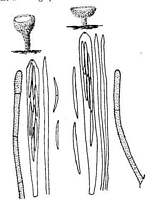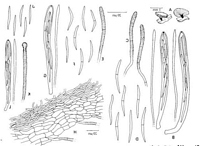|
 Lachnum nothofagi Lachnum nothofagi
SynonymsDasyscyphus emerici var. nothofagi
BiostatusPresent in region - Indigenous. Non endemic
Images (click to enlarge)
Caption: FIG. 7. Left: Dasyscyphus emerici, type collection. Right: D. emerici var. nothofagi.
Habit
sketch x 10, details x 660. | 
Caption: Figure 115. A-H. Lachnum nothofagi. A-D. Holotype. A. Apothecia. B. Asci and
paraphyses. C. Hairs. D. Ascospores. E-H. Beaton 81. E. Hair. F. Ascospores. G. Ascus
and paraphysis. H. Ectal excipulum near margin.
J-L. Dasys |
Article: Spooner, B.M. (1987). Helotiales of Australasia: Geoglossaceae, Orbiliaceae, Sclerotiniaceae, Hyaloscyphaceae. Bibliotheca Mycologica 116: 711 p.
Description: APOTHECIA scattered or gregarious, superficial, stipitate. DISC 0.5-1.8 mm diam., plano-concave, pale yellowish-brown or orange-brown when rehydrated, darker when dry, smooth.
RECEPTACLE shallow cupulate to patellate, concolorous where abraded, but clothed with
whitish or pale brown hairs. STIPE central, tapered, usually shorter than disc diam., often
dark towards the base, otherwise concolorous and similarly clothed with hairs. HAIRS
whitish or pale brown, sometimes darker brown in irregular patches near the margin, rarely
with any trace of resinous exudate, cylindric or narrower below, obtuse, septate, thin-walled,
granulate throughout their length or often becoming smooth below, sometimes more coarsely
granulate towards the apex 50-80(-100) x 3-4 µm. ASCI (90-)98-112(-120) x (6-)7-9 µm, 8-spored, cylindric-fusoid, apex narrowed and bluntly conical, the pore blue in Melzer's reagent.
ASCOSPORES 26-37 x 1.7-2.5, mean 31.5(SD 2.6) x mean 2.0(SD 0.2) µm in the holotype,
narrowly fusoid, frequently curved or sinuous, hyaline, becoming 1-septate, overlapping in 2
or 3 series within the ascus. PARAPHYSES cylindric or sometimes narrowly lanceolate,
narrowed but not acutely pointed at the apex, septate, 2-3 µm diam., not or only slightly
exceeding the asci. SUBHYMENIUM 30-40 µm thick, hyaline composed of interwoven
hyphae 1.5-2.5 µm diam. MEDULLARY EXCIPULUM composed in the stipe of compact,
vertically arranged hyphae 2.5-5.0 µm diam., radiating into the receptacle to form a layer c. 60
µm thick at the base of the receptacle, narrowing towards the margin. In the centre of the
receptacle and upper part of the stipe composed of similar, rather loosely interwoven hyphae.
ECTAL EXCIPULUM composed of hyaline or pale brown, thin-walled prismatic cells 15-22(-35) x 3.5-8.0 µm lying at a low angle to the surface and forming a layer up to 60 µm thick
at the base of the receptacle. Towards the base of the stipe the cells of the ectal layer become
smaller, thicker walled and more deeply pigmented, mostly 5-10 x 2-4 µm at the extreme stipe
base.
Habitat: Saprophytic, on dead bark of Nothofagus menziesii and
on wood of undetermined trees.
Distribution: Australia, New Zealand.
Notes: This was originally described as a variety of Dasyscyphus emerici. Apothecia of the type of
that species (India, Nilgiri Hills, on dead stem (? Rubus), no. 90) though similar in general
appearance, have a somewhat darker disc and shorter, non-septate spores 18-26 x 1.7-2.5 µm,
smaller asci 75-85 x 5-0-6.5 µm and hairs which are almost always swollen and thicker walled
at the apex. The taxa seems closely related but, in view of these differences and that of
substrate, are probably best regarded as specifically distinct. The relationship between the
present species and L. melanophthalmum is also close. Lachnum nothofagi lacks the dark
disc of that species and rarely has any resinous exudate on the hairs, and although there is little
difference in hairs, spore length or ascus size, it is probably specifically distinct.
Variation in spore length has frequently been noted for related species of Lachnum and,
unless large numbers of collections are available, as examined for example by Haines &
Dumont (1984) in their investigation of the long-spored lignicolous taxa, species delimitation
may present difficulties and require subsequent revision. The two Australian collections here
interpreted as conspecific with L. nothofagi differ slightly in spore length but agree well in
other respects and do not provide evidence for a continuous series linking this species with L.
melanophthalmum and Dasyscyphus emerici. There is intergradation and no great difference
in spore length between them and, although one collection (Beaton 93) has some apothecia
with hairs apically encrusted with amber-coloured resin, they probably fall within the range of
variation of a single species.
Dennis (1961) discussed the relationship of L. nothofagi with the Javanese Dasyscypha
javanica Penzig & Saccardo and D. ochroleucus Penzig & Saccardo. The former was shown
by Haines (1980) to be a synonym of D. oncospermatis and is evidently restricted to fern
stems. However, the latter, on bark in Java, is very like L. nothofagi with spores described as
27-28 x 3 µm and, as figured by Penzig & Saccardo, (1904), very similar in shape, but lacking
septa. I have not seen material but it is possible that this may provide an earlier name for L.
nothofagi.
Article: Dennis, R.W.G. (1961). Some inoperculate Discomycetes from New Zealand. Kew Bulletin 15(2): 293-320.
Description: Apothecia scattered, superficial, on bark, disc concave, about i mm. diameter, brown;
receptacle concolorous, with short cylindrical stalk, clothed with whitish downy hairs which
are cylindrical, obtuse, sparingly septate, with thin, hyaline, finely granulate walls, about 70 x
3-3.5 µ. Asci cylindric-clavate, 8-spored, 100-105 x 7-8 µ, the minute pore blued by Melzer's
reagent; ascospores 2-3-seriate, narrowly fusoid, 22-32 x 2-2.5 µ; paraphyses cylindrical with
pointed tips, 2-2.5 µ wide, no longer than the asci.
Notes: D. emerici was on herbaceous stems in the Nilgiri Hills, India. Externally it is
indistinguishable from Dingley 18986 but yields ascospores 18-22 x 1.5 µ in asci 85 x 8 µ.
The hairs of D. emerici vary between hyaline and light brown. Phillip's manuscript notes with
the type specimen indicate that he found ascospores 25-30 µ and the size given in the
diagnosis was 18-25 x 2 µ. The Indian and New Zealand fungi certainly seem closely allied but
in view of the apparent difference in spore size and the widely different substrata I feel it
unwise to regard them as identical. Their relationship to D. javanicus Penz. & Sacc., on ferns,
with ascospores 16-22 x 2-2.5 µ and D. ochroleucus Penz. & Sacc., on bark, with ascospores
27-28 x 3 µ, needs further study.
|